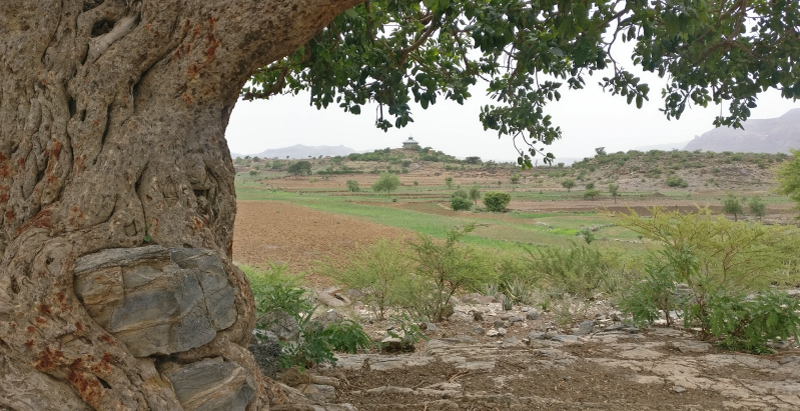 View across the Tigray teff fields with Matheos Formation limestone boulders stuck in a tree trunk
View across the Tigray teff fields with Matheos Formation limestone boulders stuck in a tree trunk
The lead-up to the Sturtian Snowball Earth: Neoproterozoic chemostratigraphy time-calibrated by the Tambien Group of Ethiopia
Abstract
The Tonian-Cryogenian Tambien Group of northern Ethiopia is a mixed carbonate-siliciclastic sequence that culminates in glacial deposits associated with the first of the Cryogenian glaciations—the Sturtian “Snowball Earth.” Tambien Group deposition occurred atop arc volcanics and volcaniclastics of the Tsaliet Group. New U-Pb isotope dilution−thermal ionization mass spectrometry (ID-TIMS) dates demonstrate that the transition between the Tsaliet and Tambien Groups occurred at ca. 820 Ma in western exposures and ca. 795 Ma in eastern exposures, which is consistent with west to east arc migration and deposition in an evolving back-arc basin. The presence of intercalated tuffs suitable for high-precision geochronology within the Tambien Group enable temporal constraints on stratigraphic data sets of the interval preceding, and leading into, the Sturtian glaciation. Recently discovered exposures of Sturtian glacial deposits and underlying Tambien Group strata in the Samre Fold-Thrust Belt present the opportunity to further utilize this unique association of tuffs and carbonate lithofacies. U-Pb ID-TIMS ages from zircons indicate that Tambien Group carbonates were deposited from ca. 820 Ma until 0−2 m.y. before the onset of the Sturtian glaciation, making the group host to a relatively complete carbonate stratigraphy leading into this glaciation. New δ13C and 87Sr/86Sr data and U-Pb ID-TIMS ages from the Tambien Group are used in conjunction with previously published isotopic and geochronologic data to construct newly time-calibrated composite Tonian carbon and strontium isotope curves. Tambien Group δ13C data and U-Pb ID-TIMS ages reveal that a pre-Sturtian sharp negative δ13C excursion (referred to as the Islay anomaly in the literature) precedes the Sturtian glaciation by ∼18 m.y., is synchronous in at least two separate basins, and is followed by a prolonged interval of positive δ13C values. The composite Tonian 87Sr/86Sr curve shows that, following an extended interval of low and relatively invariant values, inferred seawater 87Sr/86Sr rose ca. 880−770 Ma, then subsequently decreased leading up to the ca. 717 Ma initiation of the Sturtian glaciation. These data, when combined with a simple global weathering model and analyses of the timing and paleolatitude of large igneous province eruptions and arc accretion events, suggest that the 87Sr/86Sr increase was influenced by increased subaerial weathering of radiogenic lithologies as Rodinia rifted apart at low latitudes. The following 87Sr/86Sr decrease is consistent with enhanced subaerial weathering of arc lithologies accreting in the tropics over tens of millions of years, lowering pCO2 and contributing to the initiation of the Sturtian glaciation.